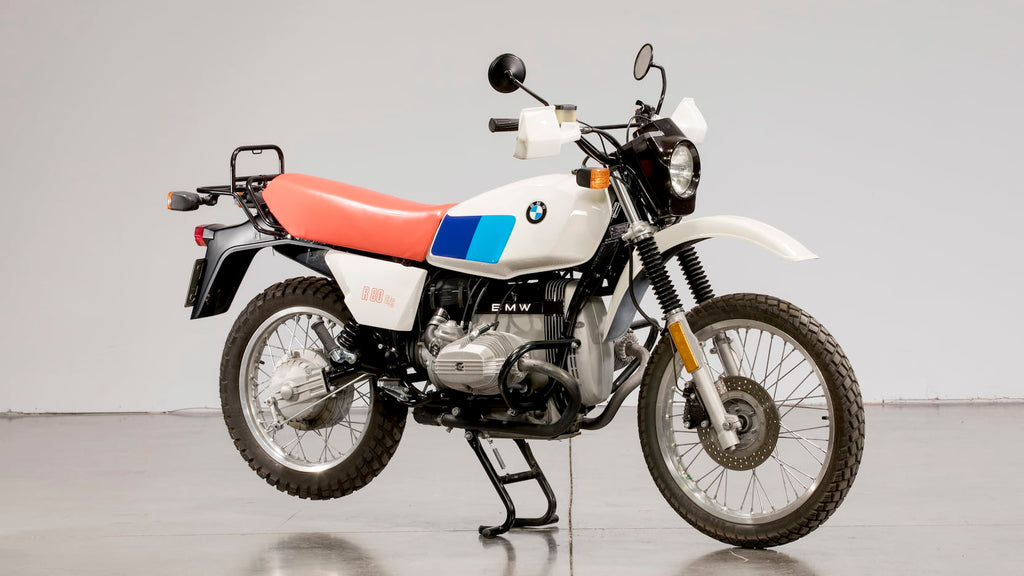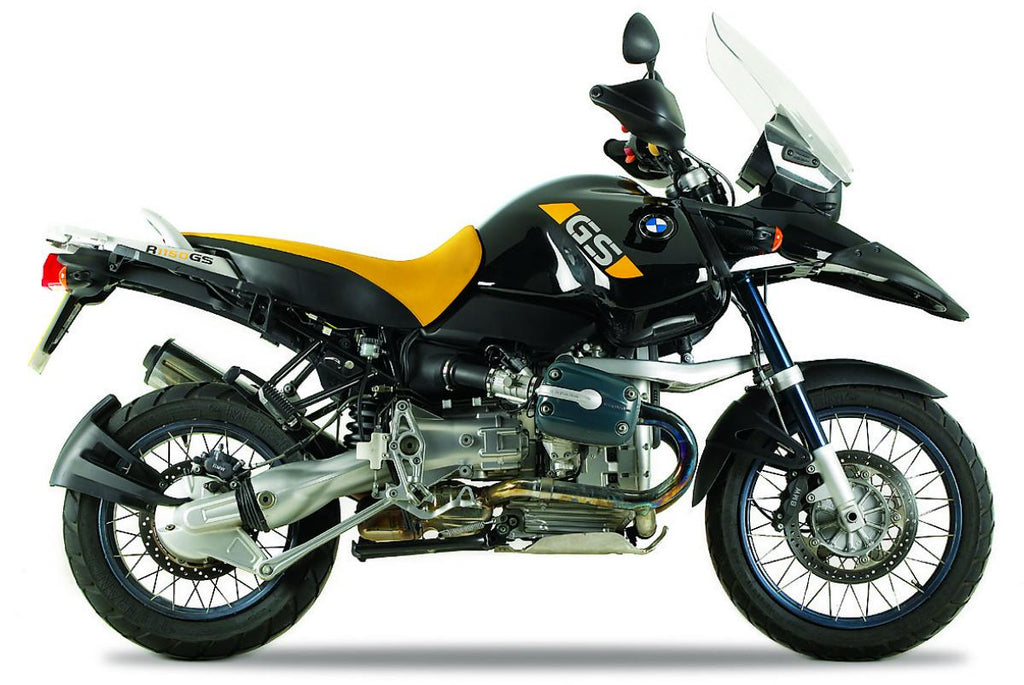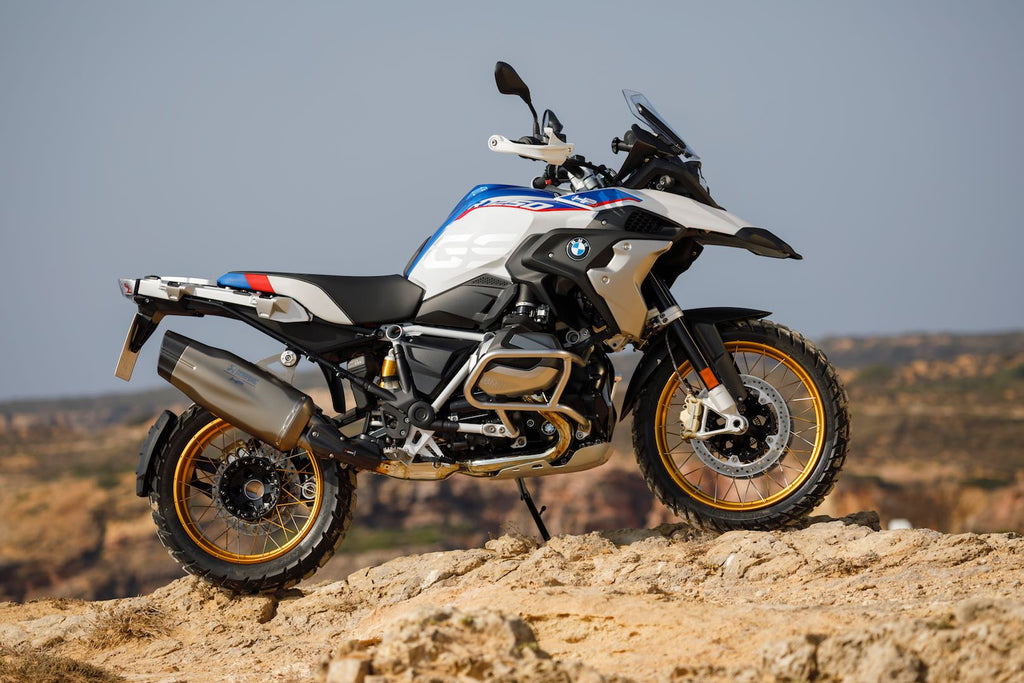History of All BMW GS Models since the 1980 R80 G/S

Think ADV touring. Long stints of unknown backcountry dirt roads, paved canyon twisties, endless highway miles, plus a few tricky double-track trails thrown in just for fun. Add in treacherous weather conditions and most riding including remote locations with fuel stops few and far between.
Now, what’s the first motorcycle comes to mind to conquer challenges? It’s nearly impossible to imagine the ADV touring segment without the BMW GS platform.
The BMW GS has been defining the category since way back in 1980 when the original R80 G/S hit the market, but continuously evolving through several model iterations into a more capable motorcycle over the years, now represented by the technologically advanced R 1250 GS.
That said, every iteration of the GS deserves respect. In the section below, we dive into the highlights of each model…all the way back to 1980!

BMW R80 G/S
The R80 G/S is the ADV bike that ignited BMW’s run in the segment, often being referred to as the first “adventure motorcycle.”
Originally introduced in 1980, the R80 was powered by a 797.5cc BMW type 247 engine—which is an air-cooled, flat-twin boxer engine, also known as an “airhead.”
The engine was fitted into the same basic chassis as the R65 but came equipped with a single-sided swingarm and driveshaft with suspension damping provided via a single shock absorber—also known as the Monolever system. Out front, the G/S was fitted with telescopic forks and a single 260mm disc brake.
Production of the R80 G/S ran from 1980 to 1987, including R80 G/S Paris Dakar edition, which featured a larger 31.8 liter (8.4-gallon) fuel tank. Simply put, it laid the groundwork for the successors to come.
- 5cc air-cooled, flat-twin boxer engine known as the “airhead”
- Monolever suspension
- Production years: 1980-1987
BMW R80 GS & R100 GS
In 1987, the German company dropped the “G/S” designation, which roughly translates to off-road/on-road, for a simpler “GS.”
BMW updated the model with a new Paralever suspension system after criticism of the outgoing Monolever, which would jack up the rear end under acceleration causing poor handling. The Paralever added a torque rod to the outer casing to combat the issue and strengthen the swingarm-to-final-drive connection. The bodywork was also revised.
A larger displacement R100 GS was also added to the lineup, offering a 980cc powerplant.
Production of the standard R80 GS and R100 GS models was halted in 1995, but the special edition “Paris Dakar”, “Basic”, and “Kalahari” models were offered through the end of 1997. The cease of production of the R80 and R100 ended the “airhead” era.
- Simpler GS designation
- Larger displacement, 980cc R100 GS model offered
- Updated Paralever system
- Production 1987-1994
BMW R 1100 GS & R 850 GS
BMW entered the R 1100 GS into the market in 1994, signaling the end of the “airhead” line and beginning of the “oilhead” family. The new model introduced partial oil cooling and a four-valve per cylinder platform to the GS lineup in form of a 1,085cc flat-twin boxer engine. Motronic fuel injection was also incorporated on the R 1100, ditching the old-school carburetors in search of a more efficient fueling.
The R 1100 GS used the same rear suspension and paralever swingarm system as the outgoing models, but was upgraded with a remote preload adjuster for the rear shock. A new “Telelever” front suspension system was also used.
- Oil-cooled, four-valve 1,085cc flat-twin boxer powerplant
- Incorporation of fuel injection
- Telelever front suspension
- Remote preload adjuster for rear shock
- Production years: 1994-1999
BMW introduced a smaller displacement 848cc R 850 GS, which was produced from 1996-2001.

BMW R 1150 GS
BMW replaced the R 1100 GS in 1999 with the R 1150 GS. The new model was powered by a 1,130cc horizontally opposed engine and shaft drive, most notably featuring a six-speed gearbox instead of the outgoing five-speed.
The R 1150 GS Adventure was also offered from 2001 to 2005, aiming at offering additional off-road prowess to the GS line.
The Adventure came packed with a 29.9-liter (7.9-gallon) fuel tank, larger windscreen, single-piece seat, and an additional 20mm (0.8 inches) of suspension travel front and rear. A lower first-gear ratio was also equipped to the GS A for navigating slow-speed sections of trail.
- 1,130cc horizontally opposed engine w/ six-speed gearbox
- Off-road oriented R 1150 GS Adventure model
- Production years: 1999-2005
BMW R 1200 GS
The R 1200 GS and R 1200 GS Adventure were launched in 2004, offering a significant improvement over the outgoing R 1150. The big news? The updated platform shredded a claimed 66 pounds in comparison to the 1150, while producing 19% more horsepower ( a claimed 105 ponies).
In 2008, BMW announced an additional bump in power—a claimed total of 105 horsepower—but also gaining significant electronic rider aids including Electronic Suspension Adjustment (ESA) and Automatic Stability Control (ASC) traction control.
Finally, in 2013, BMW Motorrad unveiled a water-cooled, opposed-twin engine for the first time in the GS platform. Other updates throughout the remainder of the R 1200 GS run included a quickshifter, LED lighting, keyless ignition, cornering ABS and more.
- 1,170cc horizontally-opposed twin engine
- The 2013 model year marked the introduction of water cooling
- Introduction of full electronic rider aids suite
- Production years: 2004-2012, 2013-2019 (liquid-cooled)

BMW R 1250 GS
BMW Motorrad unveiled the R 1250 GS and GSA for the 2019 model year, boasting key upgrades including a displacement increase, BMW ShiftCam technology, and more.
Engine displacement was increased thanks to a new bore and stroke configuration—from 101.0 X 73.0 mm to 102.5 X 76.0mm—ultimately resulting in 1,254cc worthy of a claimed 136 horsepower at 7,750 rpm and a 14-percent increase in torque. Impressive, sure.
The biggest news, however, was the use of ShiftCam technology to make use of the added displacement. The variable valve timing system helps achieve a superbly tractable and broad powerband through the use of two intake cam lobes that are utilized as engine load changes.
The R 1250 GS is packed with the latest technology, too. A 6.5-inch TFT dashboard and Multi-Controller wheel offer access to the electronic suite, while the motorcycle can also interact with your smartphone via the BMW’s Connected app. It also comes packed with various riding modes, traction control, Hill Start Control, cornering ABS, a quickshifter, semi-active suspension and more. This is the most advanced GS to date.
- 1,254cc horizontally-opposed twin engine
- Inclusion of BMW ShiftCam technology
- Production years: 2019 and on
BMW F 650 GS
The BMW F 650 GS was produced from 2000-2007, offering a lower-displacement and more off-road oriented platform to the market. The F 650 was powered by a 652cc liquid-cooled, single-cylinder powerplant.
A “Dakar” model was offered following Richard Sainct’s victories, which included longer-travel suspension, a 21-inch front wheel (as opposed to a 17 or 18-inch wheel on the standard models) and a thicker seat
- 652cc liquid-cooled, single-cylinder engine
- Production years: 2000-2012
BMW F 800 GS and F 850 GS
BMW updated the “middleweight” GS line in 2008, offering the F 800 GS. The new motorcycle featured a 798cc liquid-cooled, parallel-twin engine for the first time. It also came equipped with a larger 23.8-liter (6.3-gallon) fuel tank and larger windscreen and fairing than the outgoing F 650.
In 2019, the F 850 GS was unveiled. The updated model gets an increase in displacement—from 798cc to 853cc—which contributes to a five horsepower increase over its predecessor.
A wider-ratio transmission is also complemented by an up-and-down quickshifter, plus an electronic rider-aid suite sweetens the ride. ABS Pro, cruise control, and heated grips are nice touches, too.
- F 800 – 798cc liquid-cooled parallel-twin
- F 850 - 853cc liquid-cooled parallel-twin engine
- Full electronic rider aid suite for the F850
- Increased horsepower
- Production years 2008-2018 (F 800), 2019 and on (F 850)

